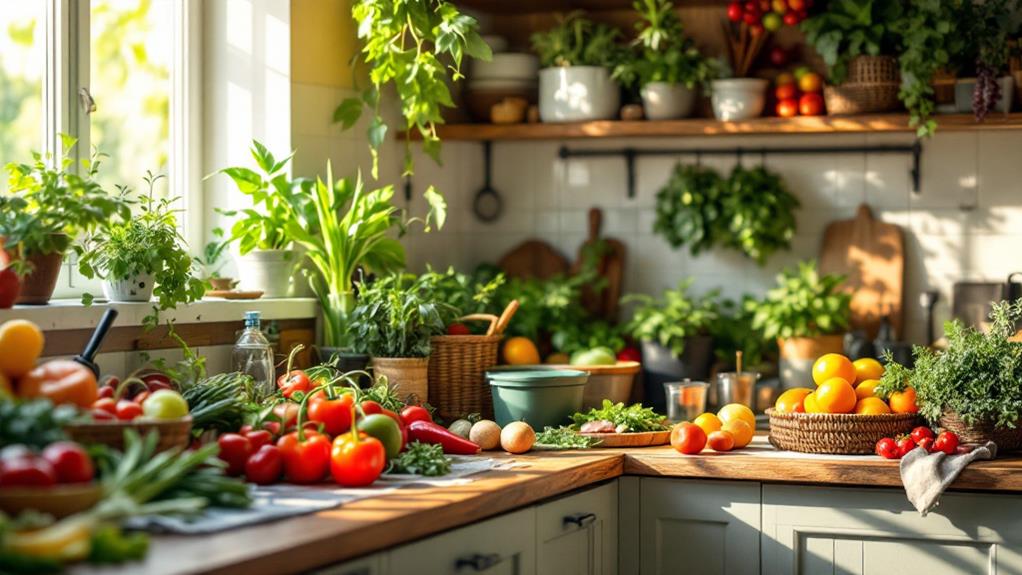Tips for Cooking With Stainless Steel Pans: Mastering the Art of Stainless Steel
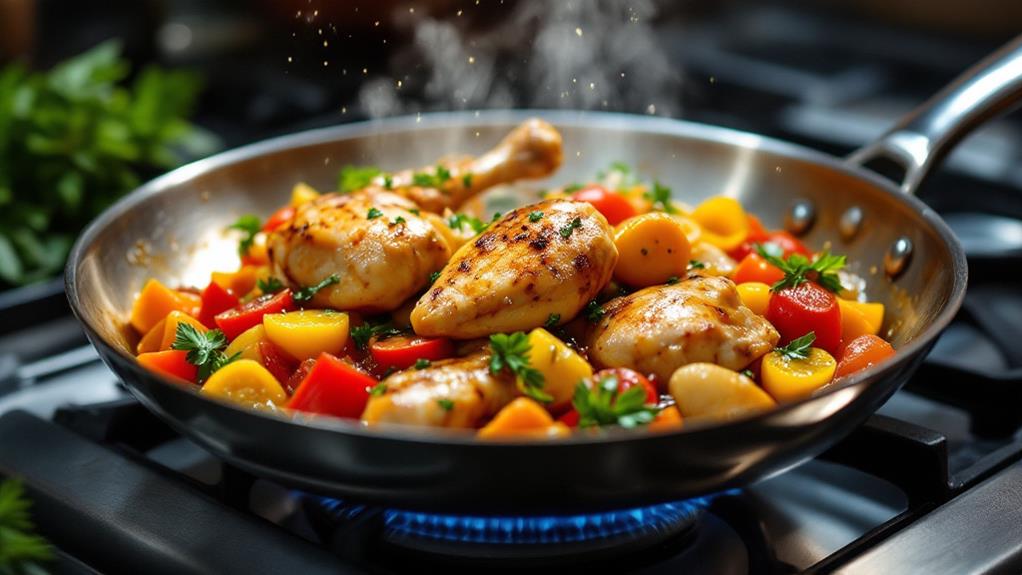
To excel with stainless steel pans, begin by preheating on medium heat until water droplets sizzle; this guarantees even cooking. Use oils like avocado for high heat or olive for medium, and add them after preheating to create a natural non-stick surface. Manage heat carefully—start with medium and adjust as needed for perfect browning. Avoid overcrowding to promote even cooking. Patience is key; let ingredients rest without constant stirring. After cooking, cool the pan before washing and dry immediately to maintain its luster. With these techniques, your culinary ventures will get richer, and there's so much more to investigate ahead.
Benefits of Stainless Steel Cookware
When you're considering upgrading your kitchen tools, stainless steel cookware stands out for its remarkable durability. It's renowned for resisting rust and corrosion, making it perfect for withstanding high heat and frequent cooking. This means you can confidently use it in different culinary environments without worrying about damage.
Stainless steel's non-reactive nature is a game-changer in cooking. You can prepare acidic foods without the cookware altering the taste or integrity of your ingredients. It's a relief to know your meals will retain their natural flavors, allowing you to focus on creating delicious dishes.
One of the standout features of stainless steel cookware is its excellent heat conductivity. This guarantees even cooking and browning, which is essential for searing, simmering, and sautéing. You'll achieve ideal results with your food every time. Furthermore, stainless steel is easy to clean, often requiring just warm, soapy water and occasional polishing to maintain its shine.
The versatility of stainless steel cookware is unmatched. It's compatible with all stovetops, including gas, electric, and induction. This flexibility caters to different cooking preferences and styles, making it an invaluable enhancement to any kitchen.
Preheating Techniques
To truly harness the benefits of stainless steel cookware, mastering preheating techniques is vital. Start by preheating the pan over medium heat for a few minutes. This step guarantees even heat distribution, which is fundamental to prevent food from sticking. To check if the pan is ready, try a simple water test: sprinkle a few droplets of water on the surface. If they dance and sizzle, you're good to go. This means the pan is preheated adequately and ready to deliver peak cooking results.
By confirming the pan is hot enough before adding oil or butter, you create a non-stick surface. This technique prevents fats from absorbing into the metal, which is critical for achieving that perfect sear or caramelization on your food. Remember, skipping the preheating step can lead to uneven cooking and an increased risk of food adhesion, ultimately diminishing your cooking experience.
Using a high smoke oil is advisable since it withstands the heat better, allowing you to focus on mastering the art of cooking without worrying about burning. With these preheating techniques, you'll enhance your stainless steel cooking, making each meal a culinary success.
Oil and Butter Usage
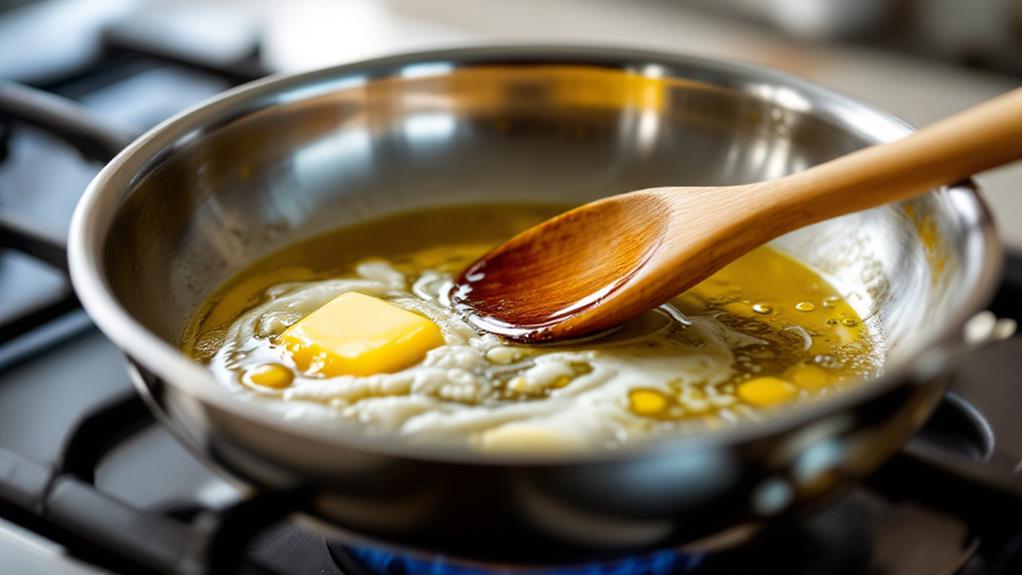
Start off by adding oil or melting butter in your preheated stainless steel pan to create a non-stick surface that improves your cooking performance. This vital step helps you avoid sticking, making your cooking experience smoother and more enjoyable. When you choose your oil, consider its smoke point. For medium heat, olive oil is a great choice, but if you're cranking up the heat, opt for avocado oil, which can withstand higher temperatures without burning.
Once the oil or butter is added, swirl it around the pan to guarantee an even coating on the cooking surface. This even distribution is key to keeping food from sticking. Keep an eye on the oil or butter; when the oil shimmers or the butter bubbles, it's ready for your ingredients. This readiness is an indicator of the perfect moment to start cooking, assuring your stainless steel pans work their magic.
Using fats effectively not only avoids sticking but also enhances the flavor of your dish. The oil or butter you choose imparts its unique taste profile, improving your culinary creations and making each meal a delightful experience.
Heat Management
Managing heat effectively is crucial when cooking with stainless steel pans. You'll find that stainless steel pans respond quickly to temperature changes, so starting with medium heat is key. Preheat your pan on medium to guarantee a consistent temperature before adding ingredients. This step helps in preventing food from sticking and promotes even cooking. Once the pan is preheated, add your ingredients, and let them sit undisturbed to achieve proper browning and caramelization.
If you're searing or boiling, use high heat, but be cautious. High heat is perfect for these techniques, but it can easily burn delicate foods if you're not careful. Always keep an eye on the pan and adjust as necessary.
One common mistake is overcrowding the pan. Avoid overcrowding to allow heat to circulate properly around the food. This guarantees even cooking and helps maintain the pan's temperature. Remember, adding cold ingredients can lower the pan's heat, so let it recover before continuing to cook.
Cooking with stainless steel may come with a learning curve, but mastering heat management will help you achieve delicious results every time.
Cooking Patience and Timing
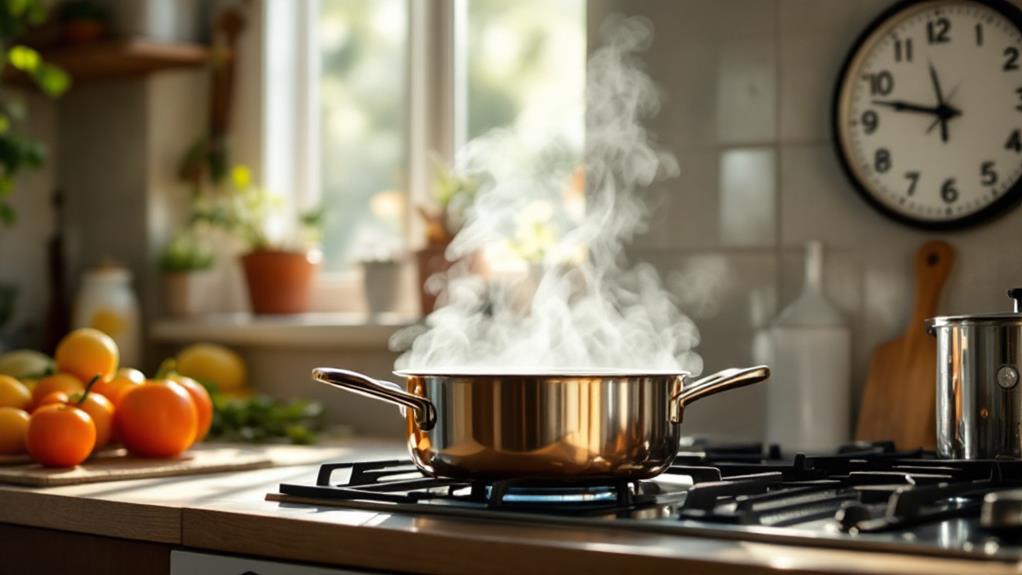
While mastering heat management lays the foundation for successful cooking with stainless steel pans, honing your patience and timing takes your skills to the next level. Cooking patience is vital when working with a stainless steel surface. To achieve beautifully seared meat, allow sufficient time for a crust to develop. Don't rush by moving the meat too soon. This waiting game improves flavor and texture through caramelization. Timing is everything; different proteins and vegetables cook at varying rates. Pay attention, adjust heat as needed, and start with medium heat to prevent burns and guarantee your food cooks evenly.
Avoid constant stirring. This common mistake prevents even browning and compromises the comprehensive cooking outcome. Letting your food rest in the pan allows it to release naturally, resulting in better browning and enhanced flavor. Stainless steel's heat conductivity means it responds well to temperature changes, so use this feature to your advantage. Start at high heat for searing, then reduce as needed. Remember, patience is key. Trust the process, and allow your dishes the time they need to develop rich flavors and textures. With practice, you'll find that patience and timing transform your stainless steel cooking experience.
Cleaning and Maintenance
Keeping your stainless steel pans in top condition requires proper cleaning and maintenance. Start by letting your pans cool down before washing them. Washing hot pans can cause warping, so give them a little time. Once cooled, use warm soapy water and a soft sponge to clean. Avoid abrasive materials since they can damage the surface and reduce the shine of your stainless steel cookware.
For stubborn stains, don't panic—just soak the pan in warm soapy water. This helps loosen any debris, making it easier to remove. Remember, a soft sponge is your best friend here; harsh scrubbing isn't necessary. Regular polishing with a dedicated stainless steel cleaner will not only maintain the luster but also extend the lifespan of your cookware. It's a simple step, but it makes a big difference.
Preventing water spots is another crucial part of maintenance. Make sure to dry your pans immediately after washing. Leaving them wet could lead to spots or other issues from prolonged exposure to moisture. By following these tips, your stainless steel pans will remain in excellent condition, ready for your next culinary adventure.
Avoiding Common Mistakes
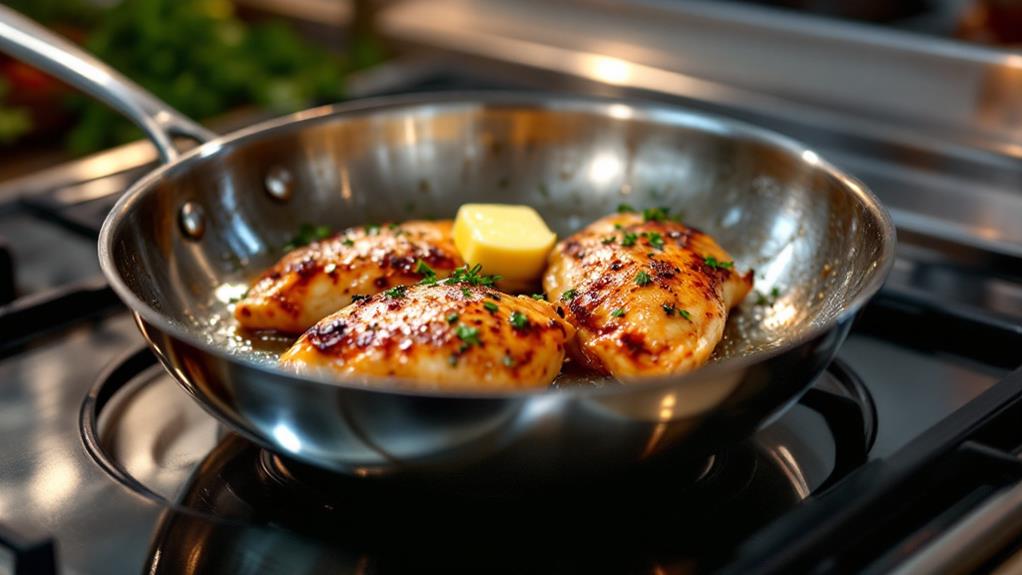
When cooking with stainless steel pans, it's crucial to steer clear of common mistakes that could damage your cookware. Initially, always remember to preheat your pan over medium heat. This helps avoid overheating, which can warp your stainless steel pans and complicate cleaning. Once preheated, add a small amount of oil. This not only improves flavor but also helps create a natural non-stick surface, reducing the likelihood of food sticking and burning.
Avoid using high heat unless necessary, as this can lead to warping and discoloration. High heat also increases the chance of food sticking, making cleanup more challenging. For cleaning, use a soft sponge or cloth with mild dish soap to remove stains and maintain the pan's appearance. Harsh chemicals and abrasive scrubbers can scratch the surface, reducing your pan's performance.
Never wash your stainless steel pans while they're still hot. Allow them to cool to prevent warping. Furthermore, avoid putting them in the dishwasher; the high heat and strong detergents can cause damage over time. Lastly, always dry your pans thoroughly before storing them to prevent rust. By following these tips, you'll extend the life of your stainless steel cookware.
Seasoning Stainless Steel Pans
To get the best out of your stainless steel pans, seasoning them can make a world of difference. Start by ensuring your pan is preheated and ready. This step is essential because it allows the oil to bond properly with the pan, creating a non-stick surface. Use an oil with a high smoke point, like canola or grapeseed. These oils are less likely to burn, ensuring a successful seasoning process. Apply a thin layer of oil to the pan, and let it heat until it reaches its smoke point. This results in polymerized oil that coats the pan, making it ideal for searing and ensuring your food cooks without sticking.


